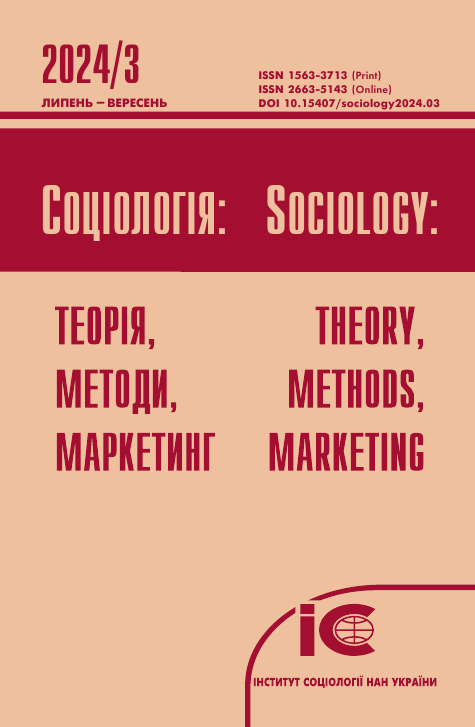GENERATIONAL DIFFERENCES IN SOCIAL SITUATION PERCEPTION
stmm. 2022 (3): 105-120
DOI https://doi.org/10.15407/sociology2022.03.105
LINA MALYSH, Doctor of Sciences in Sociology, Associate Professor of Department of Sociology, National University of Kyiv Mohyla Academy (8/5, Voloska St., Kyiv, 04070)
malysh.lina@ukma.edu.ua
https://orcid.org/0000-0003-3155-3209
The article provides an intergenerational comparison of the individuals’ position in the social structure and their attitudes to the social situation. Additionally, associations between these parameters were identified. Four subsamples which represented four generations (post-war, transitional, perestroika time and post-Soviet) selected from joint data set of the Ukrainian Society sociological survey conducted by the Institute of Sociology of the NAS of Ukraine in 2018–2021. The generations were born during the period of significant events in Ukrainian history. Four kinds of indicators of the attitudes to the social situation were distinguished (perception of the state of society, orientations of individuals toward a model of social order, satisfaction with their position and the individuals’ social dysfunctions imagery). Moreover, two typologies were constructed (overall satisfaction with status and general orientation towards a model of social order). Indicators of the individual social position were as follows: educational level, family income, qualifications and spatial mobility.
There were some generational differences in the distributions of individuals along the main stratification hierarchies, as well in their satisfaction with their life and social status. At the same time, perception of the state of society, orientation towards a model of social order, and individuals’ social dysfunctions imagery had slight differences among generational cohorts.
Structural differences in the above attitudes were not very significant. The weakest structural effects on attitudes toward the state of society have been noted for the post-war generation.
Keywords: comparative study; social stratification; generation; perception of the social situation; stratification hierarchy.
References
Fosse, E., Winship, C. (2019). Analyzing age-period-cohort data: A review and critique. Annual Review of Sociology, 45, 467–492.
Kertzer, D. I. (1983). Generation as a sociological problem. Annual review of sociology, 9 (1), 125–149.
Malysh, L. (2021). Three generations of Ukrainians in stratification hierarchies: a comparative perspective. [In Ukrainian]. Sociology: Theory, Methods, Marketing, 3, 21–36. [= Малиш, 2021]
Malysh, L., Vinogradov, O. (2010). Education as a Basis of the Entry of Young People in the Labour market. [In Ukrainian]. In: S. Oksamytna, O. Vynohradov, L. Malysh, T. Martseniuk, Ukrainian Youth: from Education to Work (pp. 81–103). Kyiv: NaUKMA. [= Малиш, Виноградов 2010]
Mannheim, K. (1970). The problem of generations. Psychoanalytic review, 57 (3), 378–404.
Ortega y Gasset, J. (1933). The Modern Theme. Translated from the Spanish by James Cleugh. New York: W. W. Norton.
Semionova, V. V. (2001). Differentiation and Consolidation of Generations. [In Russian]. In: V. A. Yadov (Ed.), Russia is a Society under Transformation (pp. 256–271). Moscow: KANON-press-C. [= Семенова 2001]
Simonchuk, O. (2018). Social Classes in Modern Societies: Heuristic Potential of Class Analysis. [In Ukrainian]. Kyiv: Institute of Sociology, National Academy of Sciences of Ukraine. [= Симончук 2018]
Received 18.06.2022
GENERATIONAL DIFFERENCES IN SOCIAL SITUATION PERCEPTION
stmm. 2022 (3): 105-120
DOI https://doi.org/10.15407/sociology2022.03.105
LINA MALYSH, Doctor of Sciences in Sociology, Associate Professor of Department of Sociology, National University of Kyiv Mohyla Academy (8/5, Voloska St., Kyiv, 04070)
malysh.lina@ukma.edu.ua
https://orcid.org/0000-0003-3155-3209
The article provides an intergenerational comparison of the individuals’ position in the social structure and their attitudes to the social situation. Additionally, associations between these parameters were identified. Four subsamples which represented four generations (post-war, transitional, perestroika time and post-Soviet) selected from joint data set of the Ukrainian Society sociological survey conducted by the Institute of Sociology of the NAS of Ukraine in 2018–2021. The generations were born during the period of significant events in Ukrainian history. Four kinds of indicators of the attitudes to the social situation were distinguished (perception of the state of society, orientations of individuals toward a model of social order, satisfaction with their position and the individuals’ social dysfunctions imagery). Moreover, two typologies were constructed (overall satisfaction with status and general orientation towards a model of social order). Indicators of the individual social position were as follows: educational level, family income, qualifications and spatial mobility.
There were some generational differences in the distributions of individuals along the main stratification hierarchies, as well in their satisfaction with their life and social status. At the same time, perception of the state of society, orientation towards a model of social order, and individuals’ social dysfunctions imagery had slight differences among generational cohorts.
Structural differences in the above attitudes were not very significant. The weakest structural effects on attitudes toward the state of society have been noted for the post-war generation.
Keywords: comparative study; social stratification; generation; perception of the social situation; stratification hierarchy.
References
Fosse, E., Winship, C. (2019). Analyzing age-period-cohort data: A review and critique. Annual Review of Sociology, 45, 467–492.
Kertzer, D. I. (1983). Generation as a sociological problem. Annual review of sociology, 9 (1), 125–149.
Malysh, L. (2021). Three generations of Ukrainians in stratification hierarchies: a comparative perspective. [In Ukrainian]. Sociology: Theory, Methods, Marketing, 3, 21–36. [= Малиш, 2021]
Malysh, L., Vinogradov, O. (2010). Education as a Basis of the Entry of Young People in the Labour market. [In Ukrainian]. In: S. Oksamytna, O. Vynohradov, L. Malysh, T. Martseniuk, Ukrainian Youth: from Education to Work (pp. 81–103). Kyiv: NaUKMA. [= Малиш, Виноградов 2010]
Mannheim, K. (1970). The problem of generations. Psychoanalytic review, 57 (3), 378–404.
Ortega y Gasset, J. (1933). The Modern Theme. Translated from the Spanish by James Cleugh. New York: W. W. Norton.
Semionova, V. V. (2001). Differentiation and Consolidation of Generations. [In Russian]. In: V. A. Yadov (Ed.), Russia is a Society under Transformation (pp. 256–271). Moscow: KANON-press-C. [= Семенова 2001]
Simonchuk, O. (2018). Social Classes in Modern Societies: Heuristic Potential of Class Analysis. [In Ukrainian]. Kyiv: Institute of Sociology, National Academy of Sciences of Ukraine. [= Симончук 2018]
Received 18.06.2022
